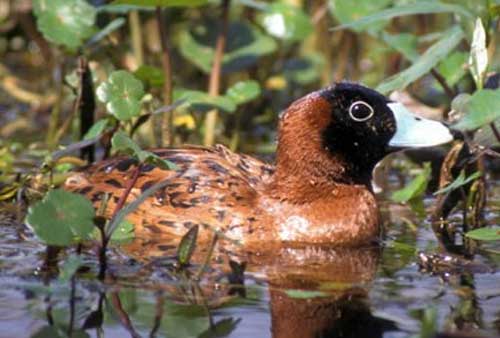
Nomonyx dominicus
Superregnum: Eukaryota
Regnum: Animalia
Subregnum: Eumetazoa
Cladus: Bilateria
Cladus: Nephrozoa
Superphylum: Deuterostomia
Phylum: Chordata
Cladus: Craniata
Subphylum: Vertebrata
Infraphylum: Gnathostomata
Superclassis: Tetrapoda
Cladus: Reptiliomorpha
Cladus: Amniota
Classis: Reptilia
Cladus: Eureptilia
Cladus: Romeriida
Subclassis: Diapsida
Cladus: Sauria
Infraclassis: Archosauromorpha
Cladus: Crurotarsi
Divisio: Archosauria
Subsectio: Ornithodira
Subtaxon: Dinosauromorpha
Cladus: Dinosauria
Ordo: Saurischia
Cladus: Theropoda
Cladus: Neotheropoda
Infraclassis: Aves
Cladus: Euavialae
Cladus: Avebrevicauda
Cladus: Pygostylia
Cladus: Ornithothoraces
Cladus: Euornithes
Cladus: Ornithuromorpha
Cladus: Ornithurae
Cladus: Carinatae
Parvclassis: Neornithes
Cohors: Neognathae
Cladus: Galloanseres
Ordo: Anseriformes
Familia: Anatidae
Subfamilia: Oxyurinae
Genus: Nomonyx
Species: Nomonyx dominicus
Name
Nomonyx dominicus (Linnaeus, 1766)
Original combination: Anas dominica
Synonymy
Oxyura dominica
Vernacular names
English: Masked Duck
español: Pato Fierro
français: Érismature routoutou
svenska: Svartmaskad kopparand
The masked duck (Nomonyx dominicus) is a tiny stiff-tailed duck ranging through the tropical Americas. They are found from Mexico to South America and also in the Caribbean. Primarily not migratory, masked ducks are reported as very uncommon vagrants in the southernmost United States, along the Mexican border and in Florida. As of 2000, the conservation status for masked ducks in Texas is 3,800 birds.[2] On April 1, 1962, it was recorded from Lowndes County, Georgia, where it was photographed by Alexander Wetmore.[3]
The only member of the genus Nomonyx, it is intermediate between the rather primitive black-headed duck (Heteronetta) and the very apomorphic true stiff-tailed ducks. It is sometimes included with the latter in the genus Oxyura, but apparently the masked ducks now are the descendants of a missing link in the Oxyurini evolution, having changed but little for millions of years.[4][5]
Breeding adult males have a rust-colored body with a black face and mottled wings. Adult females, winter males, and juveniles have a barred brownish gray body, with two horizontal, dark-colored stripes running through the buff-colored face.
These ducks mainly feed on seeds, roots, and leaves of aquatic plants. They also eat aquatic insects and crustaceans. They feed by diving. Masked ducks breed in any freshwater body with marsh vegetation and surrounded by heavy tree cover. They also occur in mangrove swamps. These ducks are usually very secretive, but they are not rare and not considered threatened by the IUCN.[1]
References
BirdLife International (2016). "Nomonyx dominicus". IUCN Red List of Threatened Species. 2016: e.T22679789A92830407. doi:10.2305/IUCN.UK.2016-3.RLTS.T22679789A92830407.en. Retrieved 12 November 2021.
Jack Eitniear (2000). "Masked duck". The Texas Breeding Bird Atlas. Retrieved March 28, 2015.
"Masked Duck, Nomonyx dominicus". River Basin Center/University of Georgia. Archived from the original on April 2, 2015. Retrieved March 28, 2015.
Livezey, Bradley C. (1986). "A phylogenetic analysis of recent anseriform genera using morphological characters" (PDF). Auk. 103 (4): 737–754. doi:10.1093/auk/103.4.737.
McCracken, Kevin G.; Harshman, John; McClellan, David A. & Afton, Alan D. (1999). "Data set incongruence and correlated character evolution: An example of functional convergence in the hind-limbs of stifftail diving ducks" (PDF). Systematic Biology. 48 (4): 683–714. doi:10.1080/106351599259979. PMID 12066296. Archived from the original (PDF) on 14 June 2011.
Further reading
del Hoyo, Josep; Elliott, Andrew & Sargatal, Jordi (eds.) (1992): Handbook of Birds of the World (Volume 1: Ostrich to Ducks). Lynx Edicions, Barcelona. ISBN 84-87334-10-5
National Geographic Society (2002): Field Guide to the Birds of North America. National Geographic, Washington DC. ISBN 0-7922-6877-6
Sibley, David Allen (2000): The Sibley Guide to Birds. Alfred A. Knopf, New York. ISBN 0-679-45122-6
Retrieved from "http://en.wikipedia.org/"
All text is available under the terms of the GNU Free Documentation License

